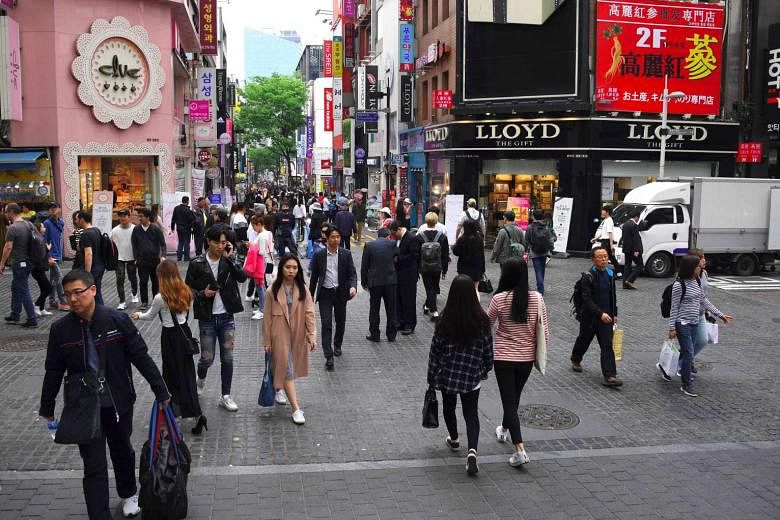SEOUL (THE KOREA HERALD/ASIA NEWS NETWORK) - It appears that the Korean economy is gaining momentum for recovery. It is encouraging to see such signs amid the crisis involving North Korea's nuclear and missile threats and the power vacuum created by the removal of Park Geun Hye as president.
The most telltale signs include the bullish performance of the stock market, with the benchmark index hitting its highest mark in six years. The stock market boom also comes with a notable improvement in consumer sentiment.
The Bank of Korea said Korea's consumer sentiment index rose for three months in a row to reach 101.2 in April, compared to 96.7 a month earlier, marking the highest monthly gain in 3 1/2 years.
Therefore, it is obvious that the recovery of consumer sentiment is not temporary.
The same government survey also highlighted the overall improvement of sentiment toward the prospects of employment, daily livelihood, household income and wages.
The rebound of exports is also one sign that the economy is brightening.
Exports, the driving engine of the economy which has been sputtering for years, are on an obvious recovery path. Korea's outbound shipments reached a more than two-year high of $48.9 billion (S$68.3 billion) last month, continuing their upward movement since last November.
The recovery of the global economy and an uptick in oil prices are helping Korean exporters.
Indeed, major exporters are filing impressive corporate earnings. Samsung Electronics registered 5.5 trillion won (S$6.8 billion) of revenue and 9.9 trillion won of operating profit in the first quarter, with the latter representing a nearly 50 per cent increase from a year ago.
SK hynix reported 6.3 trillion won of sales and 2.5 trillion won of operating profit in the first quarter, a record-high. LG Electronics posted 920 billion won in operating profit - its second-highest ever. The manufacturing sector, which grew 2 per cent, the highest since the fourth quarter of 2010, led the growth of the economy, which grew 0.9 per cent in the first quarter, up from 0.5 percent in the previous quarter.
The Bank of Korea accordingly raised its outlook for the Korean economy this year to 2.6 per cent from 2.5 per cent. The International Monetary Fund also revised its forecast for the Korean economy to 2.7 per cent from 2.6 per cent.
All these suggest that the Korean economy and the global economy are turning around. However, there is a downside as well.
One of the problems is that the expansion of exports is not yet helping to boost domestic demand and create jobs. One good example is the food services and lodging industries, which saw their output shrink for the sixth consecutive month in February.
Unemployment is still a menace. The jobless rate hit 5 per cent in February, the highest level in seven years, with the number of unemployed reaching 1.17 million in the January-March period, up 1.2 per cent from a year earlier.
Not surprisingly, the job problem is serious among Korean youths. The number of unemployed college graduates rose 9.2 per cent on-year to reach 543,000 over the three-month period, marking the first time that the figure surpassed 500,000. In addition, there is household debt, which suppresses consumer spending and which could trouble the economy further when the interest rate goes up.
There are negative external factors as well, including rising trade protectionism and the security threat from North Korea. One example is China's retaliatory economic measures against the deployment of a United States missile shield system in South Korea. It is already buffeting Korea's travel sector and other businesses that rely heavily on the Chinese market. Amorepacific, the nation's largest cosmetics company, suffered a 15 per cent drop in its first-quarter net profit.
All these call for the government and businesses to work together to reduce the potential risks and focus on boosting consumption and investment in order to put the economy into a virtuous circle.
The Korea Herald is a member of The Straits Times media partner Asia News Network, an alliance of 22 news media entities.

